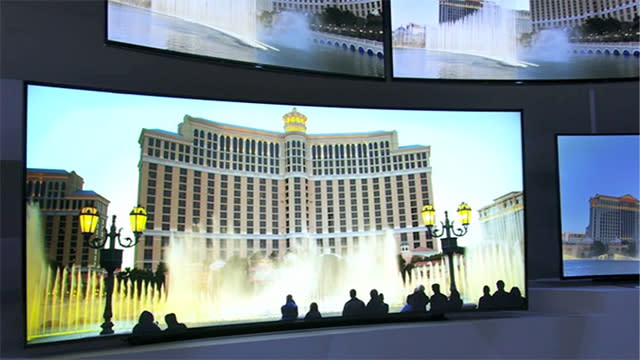Don't Buy These New TVs (yet)

Do you know what technology we spent the most money on in the lead-up to the holidays every year? TVs. After your car, it’s one of the biggest purchases you can make. So it’s worth paying attention to what’s new in TVs at the annual Consumer Electronics Show (CES) in Las Vegas.
4K High Resolution TVS are Everywhere & 3DTV is Dead
The transition to HDTV poured massive amounts of money into TV companies’ coffers, and now they want us to upgrade all the time. All the big brands tried to get us to buy into 3DTV, but sales were dismal, and at this year’s Consumer Electronics Show, it is hardly visible at all. Vizio, the leading seller of TVs in the US, killed 3D completely from all its TVs.
So the new big upgrade coming down the pike is 4K TV. It’s got 4 times the resolution of our current HDTVs, meaning 4 times the amount of visual data can be pumped into every square inch of the set. That bump in resolution is what made your jaw drop when you saw HDTV for the first time. But jumping up to 4K is not as big of an upgrade as that move from standard definition to high definition. It’s good-looking, but not revolutionary.
What Does Higher Resolution Look Like?
I always gauge resolution or image crispness by looking at video of grass. Inevitably there’s a sports video playing in one of the sets out on the CES show floor, and the level of detail you can see in the grass tells me a lot. Does it look like a green mat, do the divots look like blobby bumps, or can you see individual blades of grass? It’s probably the old jock in me assessing the field conditions, but sitting up close to a new 4K TV, I can see individual blades of grass, areas the tufts are thin, and how the divots are piling up in certain worn areas of the field. I can’t help myself, but that level of detail is cool.
Is that level of detail useful? Not really. Because when you step away to a realistic viewing distance, the image looks only slightly better than traditional HDTV. In fact as our new tech editor-in-chief David Pogue pointed out, “Mathematically, from a standard viewing distance, you can’t discern the extra pixels.” But one thing I can see in these sets is more contrast. The bright colors leap off the screen and the blacks are pitch black, not mottled or grey.
Don’t Buy Yet
Yes, the TVs are getting better from a hardware and resolution perspective, but they aren’t so revolutionary that you should run out and buy one. For one thing, there’s hardly any content available in the new 4K format yet. More video companies and studios are taking the format seriously, but the transition to all football games being broadcast in 4K will take quite a while.
The big barrier in new TV technology is always the cost; they start out expensive and eventually get much cheaper. This year we’re seeing the start of that transition. One of the 55-inch Samsung models we looked at will cost between $5,000 and $7,500 when it releases later this year. But the big news here is that Vizio announced it will sell a 50-inch 4K TV for $999. This price disparity is great news if you want a new TV sometime soon; it means all the TV manufacturers will have to get their prices down and fast. Keep your wallet in your purse or pants until the price wars really kick in, probably late in 2014 or early 2015.
And a final reason not to buy a 4K TV right now: some of the hardware issues haven’t been fully standardized. Sets with OLED technology (bright screens, thin sets, lower power consumption) were all the rage last year, but the exorbitant manufacturing costs have made OLED much less popular at CES this year, with Sony shunning it completely.
The Kim Kardashian Effect- CURVES
Another huge trend here at CES is curved TVs. Many of the big brands – LG, Samsung, Panasonic – are offering large sets that curve around the viewer about 5 degrees. Aside from making all video look like it was shot on a wide-angle a GoPro camera, I don’t see the benefit. And when you are sitting off to the side, not directly in front, the curvature makes the image look weird. Samsung has an adjustable set that bends inward at the touch of a button on the remote. Great party trick, dumb TV feature that I wouldn’t pay extra for. No one has offered a compelling explanation to me as to why curved is better. And I can’t see it for myself.
So take from this annual unveiling of new TV technology that manufacturers are trying to make sets look better, but that the HDTV you just purchased is still very good and will last for quite a few years without feeling outdated.
[Related: Rumored iPad Hybrid Fuels Laptop/Tablet Fight at CES ]


